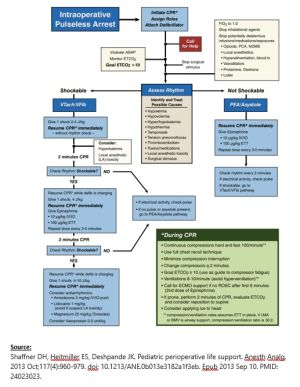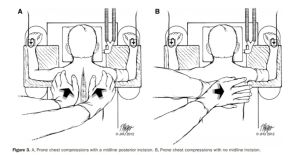Intraoperative Cardiac Arrest: Difference between revisions
No edit summary |
No edit summary |
||
| Line 40: | Line 40: | ||
# Assign roles | # Assign roles | ||
'''<u>Resuscitation Algorithm:</u>''' | '''<u>Resuscitation Algorithm for Intraoperative Pulseless Arrest:</u>''' | ||
Source: Shaffner DH, Heitmiller ES, Deshpande JK. Pediatric perioperative life support. Anesth Analg. 2013 Oct;117(4):960-979. doi: 10.1213/ANE.0b013e3182a1f3eb. Epub 2013 Sep 10. PMID: 24023023. | Source: Shaffner DH, Heitmiller ES, Deshpande JK. Pediatric perioperative life support. Anesth Analg. 2013 Oct;117(4):960-979. doi: 10.1213/ANE.0b013e3182a1f3eb. Epub 2013 Sep 10. PMID: 24023023. | ||
[[File:PALS Shaffner.jpg|thumb|Intraoperative Pulseless Arrest Resuscitation]] | [[File:PALS Shaffner.jpg|thumb|Intraoperative Pulseless Arrest Resuscitation]]Important Notes: | ||
* Medication have not been shown to change outcome, more emphasis on effective compression. | * Medication have not been shown to change outcome, more emphasis on effective compression. | ||
* Compression depth: | * Compression depth: | ||
| Line 55: | Line 54: | ||
* 100 compressions : 8-10 ventilations per min | * 100 compressions : 8-10 ventilations per min | ||
* Avoid overinflation | * Avoid overinflation | ||
* Biphasic shock | * Biphasic shock - First dose: 2-4J/kg - Second dose: 4J/kg - Third dose: 4-10J/kg | ||
* Epi dose: | * Epi dose: - 10 MICROg/kg IV/IO - 100 MICROg/kg ETT | ||
* PEA vs. VFib: PEA appears organized and pulseless | * PEA vs. VFib rhythm: PEA appears organized and pulseless | ||
* Call for ECMO if no ROSC after 6 mins | * Call for ECMO if no ROSC after 6 mins | ||
* Ice to head | * Ice to head | ||
| Line 65: | Line 64: | ||
[[File:Prone Chest Compression.jpg|thumb|Prone Chest Compression (Shaffner et al. 2013)]] | [[File:Prone Chest Compression.jpg|thumb|Prone Chest Compression (Shaffner et al. 2013)]] | ||
'''<u>Methods of Measuring Effectiveness of CPR</u>''' | |||
* ETCO2 levels >10 mm Hg are associated with higher likelihood of ROSC | |||
** >30mmHg: good | |||
** <10 mmHg: bad | |||
* Diastolic pressure on a-line (relaxation right atrial pressure): | |||
** >20 mmHg infants | |||
** >30 mmHg children | |||
** <15 mmHg - bad (in adults associated with no ROSC during CPR) | |||
* MVO2 | |||
** <30% was associated with no ROSC | |||
'''<u>Post Resuscitation:</u>''' | |||
* Avoid hypotension | |||
* Allow to be cool (avoid hyperthermia) | |||
* Avoid hypoglycemia | |||
* Avoid hyperventilation (unless herniating) | |||
'''<u>Critical Event Resources:</u>''' | '''<u>Critical Event Resources:</u>''' | ||
PEDI CRISIS APP | |||
Available on Apple Store and Google Play | Available on Apple Store and Google Play | ||
https://pedsanesthesia.org/pedi-crisis-app/ | |||
{{Stub Notice}}{{Stub Notice}} | {{Stub Notice}}{{Stub Notice}} | ||
Revision as of 17:39, 18 November 2023
Incidence of Perioperative Cardiac Arrest (CA):
Increase with higher ASA status
Wake Up Safe Registry: 3.3 per 10,000 of arrest were anesthesia related. Aesthesia-related death was 0.36 per 10,000 anesthetics.
Pediatric Perioperative Cardiac Arrest (POCA) Registry: 1.4 +/- 0.45 per 10,000 were anesthesia related. Mortality rate: 26%
Children (<12 year old): 2x more likely to experience CA, infants (<1 year old): 10x, neonates (<1month old): 50x
Causes for Pediatric Perioperative Arrest:
- CIRCULATORY FAILURE:
- Hypovolemia: Hemorrhage, inadequate/inappropriate volume resuscitation/transfusion (patients < 24 months may not respond to hypotension with increase HR)
- Hyperkalemia: Succinylcholine, TRANSFUSION (pRBC >2 weeks, speed of transfusion), reperfusion, myopathy, or renal insufficiency
- Dysrhythmia: LA toxicity, line placement (safer to use Ultrasound guided vs. landmark technique)
- Anaphylaxis
- Venous Air Embolism
- Malignant Hyperthermia: very rare
- RESPIRATORY FAILURE:
- Airway Obstruction: - Laryngospasm: Upper respiratory infection increases risk - Bronchospasm
- Inadequate ventilation and oxygenation: difficult airway, mucus plug, kinked ETT, inadvertent extubation
- Disordered control of breathing: drug overdose, neuromuscular diseases, apnea
- Aspiration
- SUDDEN CARDIAC COLLAPSE
- Bradycardia or cardiovascular collapse: - Traction, pressure, or insufflation involving the abdomen, eye, neck, or heart - Undiagnosed cardiomyopathy
- Overdose - Weight-based dosing of IV anesthetic on induction in a child with hypovolemia or compensated shock may lead to collapse
Important Resuscitation Steps:
- Inform team
- Stop surgical stimulation
- Stop anesthetics (gas & sedation gtt) and vasodilatory meds
- 100% Oxygen
- Open fluids and Trendelenburg position
- Chest-compression
- Call for help
- Consider stopping potassium containing solutions (blood or hyperalimentation)
- Ask for ice to head
- Assign roles
Resuscitation Algorithm for Intraoperative Pulseless Arrest:
Source: Shaffner DH, Heitmiller ES, Deshpande JK. Pediatric perioperative life support. Anesth Analg. 2013 Oct;117(4):960-979. doi: 10.1213/ANE.0b013e3182a1f3eb. Epub 2013 Sep 10. PMID: 24023023.

Important Notes:
- Medication have not been shown to change outcome, more emphasis on effective compression.
- Compression depth:
- For a child is at least ⅓ the depth of the chest size, or 5 cm
- For infant: 4cm
- Allow complete recoil, don’t lean on chest
- Don’t interrupt compression
- Intubate, follow ETCO2
- 100 compressions : 8-10 ventilations per min
- Avoid overinflation
- Biphasic shock - First dose: 2-4J/kg - Second dose: 4J/kg - Third dose: 4-10J/kg
- Epi dose: - 10 MICROg/kg IV/IO - 100 MICROg/kg ETT
- PEA vs. VFib rhythm: PEA appears organized and pulseless
- Call for ECMO if no ROSC after 6 mins
- Ice to head
- If prone, perform 2 mins CPR prone, evaluate EtCO2 then consider supine
- IO access is as effective as IV access and may be easier to obtain during circulatory collapse

Methods of Measuring Effectiveness of CPR
- ETCO2 levels >10 mm Hg are associated with higher likelihood of ROSC
- >30mmHg: good
- <10 mmHg: bad
- Diastolic pressure on a-line (relaxation right atrial pressure):
- >20 mmHg infants
- >30 mmHg children
- <15 mmHg - bad (in adults associated with no ROSC during CPR)
- MVO2
- <30% was associated with no ROSC
Post Resuscitation:
- Avoid hypotension
- Allow to be cool (avoid hyperthermia)
- Avoid hypoglycemia
- Avoid hyperventilation (unless herniating)
Critical Event Resources:
PEDI CRISIS APP
Available on Apple Store and Google Play
https://pedsanesthesia.org/pedi-crisis-app/
This is a Stub Notice. This page has not been completed. You can work on this page by signing in and going to the Edit tab. Thanks for helping to make PedsAnesthesia.Net Wiki useful.
Go to the Main Page to see the Topic Outline.
Go to the Generalized Suggested Outline for information on case-specific details for each page.
Go to the Test Page for examples on how to use references in the page.
Relevant Article Depot:
This is a Stub Notice. This page has not been completed. You can work on this page by signing in and going to the Edit tab. Thanks for helping to make PedsAnesthesia.Net Wiki useful.
Go to the Main Page to see the Topic Outline.
Go to the Generalized Suggested Outline for information on case-specific details for each page.
Go to the Test Page for examples on how to use references in the page.
Relevant Article Depot: